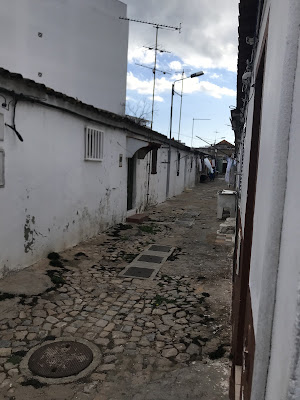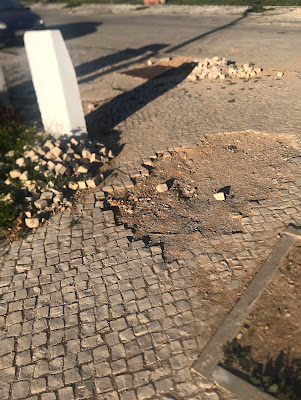If you have traveled in Portugal, or in fact any of the former Portuguese colonies including Brazil, you have experienced the beautiful, amazing, artistic plazas and pedestrian walkways with awe -and yet with trepidation and caution!
From major city to minor village, the historic centers are decorated with geometric and artistic patterns made from little limestone & granite stones called “calçada portuguesa”. These calçada cubes are about 3 inches on each side and are pounded into sand in mosaic patterns, traditionally spaced about 2 cm (3/4 inch) apart!
 |
Heavy tamper
Most of the stones are from white limestone from quarries in the algarve (near us) or just north of Lisbon and black granite from further north. Portugal is #20 on the list of countries with the number of quarries. Considering the small size of this country, that pretty interesting. |
We've read two versions of the historical beginning of these lovely pavings. Following the immense earthquake of 1755, the country needed to be rebuilt quickly and the stones were reshaped and reused from the rubble of all the destroyed buildings. Later in the 1840s convict labor was used to construct Roman-inspired calcada pavements in the Lisbon castle grounds. By far the largest and most interesting is the optical illusion of Lisbon's Rossio Square called Mar Largo ("wide sea").
 |
| It’s really flat! |
Every small town's historic center has streets with cobbled stone and calçada sidewalks. We live within the old town in Olhão called the "fisherman's quarters". Outside our door the six foot wide one-way street is cobbled.
 |
| the stones change as the name of the street changes (we live on Rua Carlos da Maia) |
There is of course a downfall to these beautiful streets and sidewalks. The smooth limestone is extremely slippery when wet and the cobbled stones are difficult to navigate on wheels--bicycles, strollers, wheelchairs and shopping trolleys. In fact there are ongoing debates about removing many of the sidewalks! Due to fewer skilled craft people (known as "calçadeiros") who are able to repair them, the sidewalks are spotted with potholes and missing stones.
Fortunately, in 2021 this traditional pavement was nominated to be included in the national inventory of "intangible cultural heritage"and presented to UNESCO to be added to the list of Intangible Cultural Heritage of Humanity, just like the traditional Portuguese music, Fado.
 |
| beautiful mosiac art |
 |
| Whimsical-this Pi equation goes on for a block |
 |
| Jack is getting his directions on the main Avenue |
 |
| streets often have dates that I think are when they were built |
We have been exploring by train and on foot these past few week and discovered the flamingos in Olhão. The Greater Flamingo (Phoenicopterus roseus) are generally winter birds who come to the Ria Formosa to feed in the abandoned saltpans, marshes and lagoons.
 |
| they are mostly white but they preen themselves with a pink oil from their glands |
For the first time in Portugal over 550 chicks hatched in the Algarve last summer! This may be attributed to the lack of disturbance from people due to the Covid-19 restrictions since the birds nest on the ground.
We took the train to the furthest city in the eastern Algarve, Vila Real de Santo Antonio which shares the border with Spain.
 |
| rural train stations have these wonderful old clocks |
We took a leisurely stroll on the lovely riverside walk along the Guadiana River (Jardim da Avenida da Republica) and of course stopped for a glass of vinho tinto (red wine).
The town was built in 1774 to claim the fishing water of the eastern Algarve from Spain and still has a ferry that crosses the border to the Spanish town of Ayamonte.
A short 30 minute ferry trip out of Olhão dropped us at the barrier island across the Ria Formosa-Ilha da Cultara to see the tiny community.
 |
| very few passengers in winter! |
But to our surprise nothing was open! We walked around hoping to find at least a coffee-nothing but the deserted, sandy oceanbeach and a labyrinth of pedestrian-only paths with seasonal houses. Looks like a lovely summer spot though.
 |
| The farol, or lighthouse, was the first one built in Portugal and still operates. |
 |
| this is the ocean side of the island |
We celebrated our 3 months of being in Portugal with a dinner at a new neighborhood restarant, Migo (slang for Amigo-"friend") in a lovingly restored building. We were the only customers that evening so the young owner treated us to his favorite playlist of rock n' roll music from our era.
 |
| the tile on the wall was discovered when they were remodeling |


























Thank you for the wonderful photos and history lesson!!! I have only seen a few of these walkways in my two trips to Portugal, my maternal heritage. ♥️
ReplyDelete